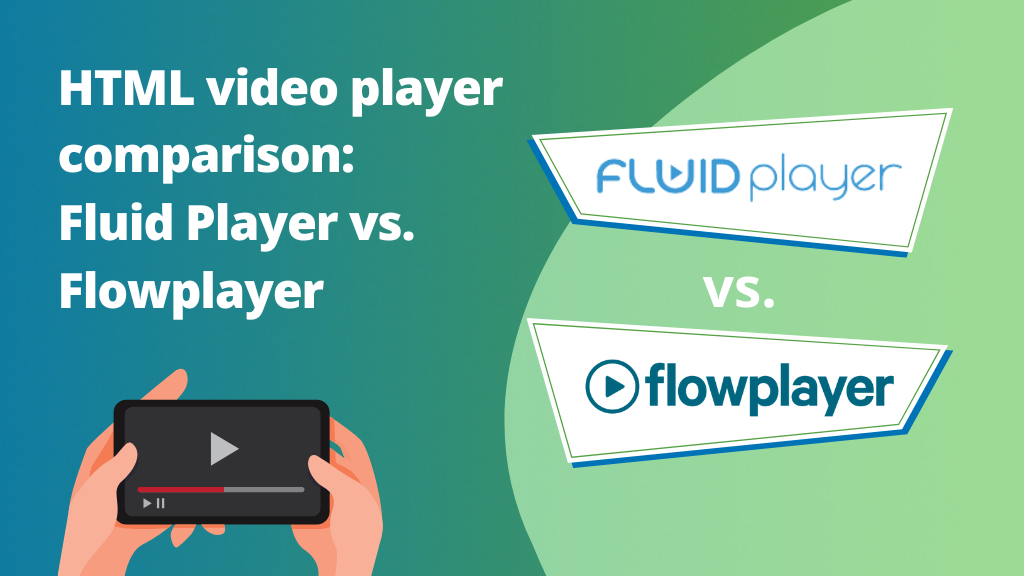HTML video player comparison: Fluid Player vs. Flowplayer

According to OptinMonster, online marketers using video get 66% more qualified leads per year, and grow revenue 49% faster than those who don’t, according to Dash. Also, including a video on a landing page can increase conversion rates by up to 80%, according to Saleslion. So, it doesn’t take a genius to conclude that video marketing is highly profitable! In order to become a part of these winning percentages, then you need a great video player that allows you to showcase your video content in all its splendor, offering a great user experience at all times. To help you pick the best video player for you we have compared the lightweight HTML open source video player Fluid Player with the proprietary software video player JW Player, and the highly flexible community maintained video player Video.JS in our HTML video player comparison series. In the last instance of this series, we will compare Fluid Player as an alternative to Flowplayer, a solid and flexible online video solution with lots of plugin integration possibilities.

As we can see on the HTML video player comparison table above, there are many similarities between Fluid Player and Flowplayer, but also a few differences. They are both HTML5 video players that allow video ad monetization, allow publishers to integrate their own CDNs, and are compatible across most platforms, devices and browsers. Both players provide common playback features, such as play, pause, seek, volume control, and fullscreen mode and support captions/subtitles. On the flip side, Fluid Player is an alternative to Flowplayer that is free to use and open source, whilst Flowplayer works on a subscription basis and has got more interface options and plugins to play with – Continue reading to learn more!
Fluid Player: Free to use, customizable, easy to integrate, seamless
The first platform that we are going to look at in this HTML video player comparison is Fluid Player: An easy to integrate lightweight open source player which allows users to freely use, customize, and distribute the player and its content. It allows multiple players per page, a range of formats for VOD and video monetization, as well as many out of the box useful features. You can find the downloadable files on GitHub, through self-hosted CDN for an easy setup, and also use The Builder for quick and easy customization. It supports a range of formats including m3u8, MPEG-DASH, HLS, MP4, and VR formats, and supports live streaming and the VAST Standards by default.
A lightweight and minimalistic player alternative to Flowplayer
Fluid Player is often referred to as lightweight because it is designed to be a minimalistic and efficient video player:
- Small File Size: The player has a relatively small file size compared to other players, making it quicker to load and reducing the bandwidth.
- Minimal Dependencies: Fluid Player aims to have minimal dependencies on external resources using standard web tech such as HTML, CSS, and JavaScript, without requiring additional plugins or frameworks.
- Optimized Performance: Lazy loading and progressive streaming ensure that only the necessary components load, reducing memory footprint and enhancing performance.
- Customizable Feature Set: Fluid Player’s modular architecture allows choosing only necessary features, excluding unnecessary functionalities that might add bulk.
Out of the box video ad monetization: A range of formats for your advertisers
Fluid Player’s video monetization features are compatible with all the ad networks, ad exchanges or video ad servers out there, and are also enabled out of the box. Offering a variety of ad formats is key to attract more advertiser clients and create demand, ultimately increasing the long-term value of your site’s ad zones. Here are some of the ad formats that you will be able to use:
- Pre, mid and post-roll video ads
- Custom HTML banner when the video is on pause, ad text message in the top right corner of the video screen
- VAST non-linear banner in-video ad overlay with image insertion (gif/jpeg/png) during video playback
- Livestream ads – Read this article to find out how to enable them
Compatible with all browsers across Tier 1, Tier 2 and Tier 3 GEOs
Fluid Player is designed to be compatible with modern web browsers so far as they support HTML5 video playback. The most commonly supported browsers for Fluid Player are:
- Google Chrome
- Mozilla Firefox
- Apple Safari
- Microsoft Edge
- Opera
- Brave
- Vivaldi
- Samsung Internet Browser
To these widely used browsers we need to add some popular ones in T2 and T3 countries, such as Puffin, and Silk Browser, which are key in order to reach audiences in countries like India, China, and similar locations in T3 ad campaigns.
Workflow flexibility: Easy integration with platforms, frameworks, and CDNs
Fluid Player offers a high level of compatibility with different frameworks and platforms in order to allow higher workflow flexibility. For instance, it is designed to work seamlessly with any CDN that you choose to use. It works with Vue.js, React and Angular out of the box, which allows you to continue working exactly as you were, without the need to export all your files or libraries, or switching platforms, nor programming models – You can simply integrate your current framework with the player. In order to start using your React library, Vue.js frameworks or integrate your Angular project, all you need to do is install the alternative to Flowplayer, Fluid Player, using Yarn or NPM and then import the Fluid Player module and attach it to a video element of your choosing. Read more about how to do it through Fluid Player’s documentation.
Flowplayer: A complete paid video solution for businesses
And the second platform to look at in this HTML video player comparison is Flowplayer: a popular HTML5 video player and platform that provides a comprehensive solution for video delivery and playback for websites. It offers a range of features and capabilities to enhance the video experience and meet the needs of developers, publishers, and businesses, and is highly customizable through a range of plugins. Publishers can use it by buying a customized subscription plan, and is designed to deliver high-quality video playback across many platforms and devices.
Content protection and DRM functionalities
Flowplayer supports Digital Rights Management (DRM) technologies to protect premium video content. It integrates with DRM systems, such as Widevine, PlayReady, and FairPlay, to secure content delivery and prevent unauthorized access. As read in their Documentation, if you prepare the player with media that is defined in the Flowplayer configuration as DRM protected, then the player will automatically take care of the DRM. If, however, you prepare the player with external media that has DRM protected content, then you will require further setup.
Hundreds of plugins for further customization
Flowplayer offers a plugin architecture that enables developers to extend the player’s features such as video analytics, VR, advertising, subtitles, social sharing, and more:
- VAST Standards and video advertising: This plugin allows to play video and text/overlay ads from multiple VAST (versions 2, 3 or 4) /VPAID (version 2) compliant tags or a single VMAP / adPod tag. Supported ad formats include pre-roll, mid-roll and post-roll.
- Airplay: Implements a Airplay feature that allows playing content on Airplay devices when they are available in the same WiFi network.
- Chromecast: Adds support for casting videos to chromecast.
- Playlists: Adds support to create and manage video playlists
Personalized user support, user profiles and roles
Flowplayer provides personalized customer support, including technical assistance and access to updates and new features, as well as a community forum where users can ask questions. Also, end users can invite their teammates to collaborate within their workspace and assign different roles:
- Organization Admin: They have full view and access to the whole workspace, and are able to invite new people and manage the overall organization.
- Workspace Admin: Allow people to manage individual workspace without having access to organization level information such as billing.
- Normal User: They can work across the workspaces with access and upload and publish assets.
Admins can also organize the workspace by functionality areas, giving access to manage the different tools and functionalities to their team members.
Live streaming tools
The Flowplayer platform offers a full range of tools and features to make live streaming easier for publishers, including:
- Instant live streaming
- Scheduled streaming with countdown for viewers
- 24/7 broadcasts
- Recording of streams with auto replacement in the embed code
- Create clips from a full live recording
- Reusable livesources which use the same input configuration for multiple separate events
- Realtime and historical usage analytics
- Simulated live streams from one or several VOD clips with configurable availability
HTML video player comparison: Fluid Player as an alternative to Flowplayer?
We hope that this HTML video player comparison, with Fluid Player as an alternative to Flowplayer, has been useful to you! Ultimately, the choice between Fluid Player and Flowplayer depends on variant factors such as licensing requirements, what features may be more useful for your specific needs, customization needs, workflow and support preferences. Both players have their strengths and can deliver a rich video playback experience for your end user, but the specific requirements of your project, as well as factors such as which workflows are your preferred ones, how many ad formats you wish to offer to your advertisers may influence which player is more suitable for your needs.